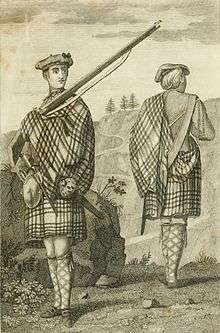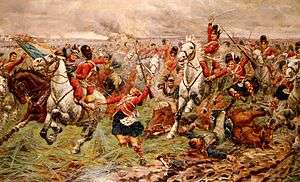Scottish regiment

A Scottish regiment is any regiment (or similar military unit) that at some time in its history has or had a name that referred to Scotland or some part, thereof, and adopted items of Scottish dress. These regiments were and are usually a product of the British Empire, either directly serving the United Kingdom, serving as colonial troops, or later as part of Commonwealth country military establishments. Their "Scottishness" is no longer necessarily due to recruitment in Scotland nor any proportion of members of Scottish ancestry. Traditionally, Scottish regiments cultivate a reputation of exceptional fierceness in combat and are often given romantic portrayals in popular media. Within Scotland, itself, regiments of the Scottish Lowlands did not adopt as strong a "Scottish" (specifically Highland Scottish) character until the late Victorian Era.
Lowland Regiments
These generally predate the more widely known Highland regiments (see below). The senior Lowland regiment was the The Royal Scots (The Royal Regiment) which dates from 1633. The Royal Scots Fusiliers and The King's Own Scottish Borderers were subsequently raised in 1678 and 1689 respectively. Throughout the 17th, 18th and most of the 19th centuries these Scottish regiments served widely and with distinction. They did not however differ significantly in appearance or public perception from the bulk of the line infantry of the British Army. In 1881 the introduction of the Cardwell system of reforms provided the opportunity to adopt a modified form of Scottish dress for the Lowland regiments. Comprising doublets and tartan trews this gave the Lowlanders a distinctive identity, separate from their English, Welsh, Irish and Highland counterparts.[1] At the same time, the absence of kilts (except for pipers) and the substitution of Kilmarnock bonnets for feather bonnets prevented confusion between Lowlanders and their Highland counterparts. The Cameronians (Scottish Rifles) was created at the same time from the merging of two existing numbered regiments.[2]
Highland Regiments

The original Highland regiments were raised in the 18th century with the object of recruiting rank and file solely from the Scottish Highlands. However, due to the Highlands becoming extensively depopulated through the course of the 19th and 20th centuries, the Highland regiments of the British Army have witnessed a long-term decline in the proportion of recruits from the Highlands and have long recruited many Lowland Scots and others. The major 20th century exceptions to this rule were the First and Second World Wars, when many Highland men joined up. Around the time that the first Highland regiments were raised the Highlands had recently been a hotbed for several revolts against the establishment, namely the Jacobite Rebellions, so the loyalties of the Highlanders were often deemed suspect in the early history of the Highland regiments.

The first Highland regiment, the Black Watch was originally raised from clans openly loyal to the status quo to police the Highlands, which were deemed to be both rebellious and lawless by the contemporary British establishment. However, due to a pressing need for personnel in North America during the Seven Years' War, William Pitt the elder made the decision to raise new Highland regiments to fight in this imperial war. The war ended in victory and among other things, Canada was secured as a part of the British Empire, while the British East India Company's position in India was consolidated and expanded, both at the expense of the French. These Highland regiments were disbanded after the war, but other Highland regiments were later raised and, like the rest of the British Army, saw service in various wars including in the British colonisation of India and the Peninsular War.
By the Victorian era the loyalty of the Highlanders was no longer suspect. Queen Victoria had a personal interest in things Scottish, in particular relating to the Highlands. In addition Highland regiments had played a conspicuous role in such Victorian conflicts as the Crimean War and the putting down of the Indian Mutiny. The Highland regiments earned a reputation which influenced the mindset of those Scottish regiments which were Lowland in origin. This resulted in the wearing of tartan by Lowland regiments which had previously wore uniforms not clearly distinguishable from their Irish, Welsh and English counterparts. In the case of the Highland Light Infantry the distinction between Highlanders and Lowlanders was slightly blurred: although classified as a non-kilted Highland regiment it was recruited from Glasgow in Lowland Scotland and bore the title of "City of Glasgow Regiment".
Scottish bagpipes have been adopted in a number of countries, largely in imitation of the pipers of Highland regiments which served throughout the former British Empire. Highland regiments were raised in a number of Commonwealth armies, often adopting formal honorary affiliations with Scottish regiments of the British Army.
Scottish Regiments of the British Army
Current Regiments
- Royal Scots Dragoon Guards
- 1st Royal Tank Regiment
- Scots Guards
- Royal Regiment of Scotland
- 19th Regiment Royal Artillery
- 40th Regiment Royal Artillery
- 105th Regiment Royal Artillery (Volunteers)
- 32 (Scottish) Signal Regiment
- The Scottish Transport Regiment
- The London Scottish (a Company of The London Regiment)
- The Liverpool Scottish (a platoon of the 4th Battalion, Duke of Lancaster's Regiment)
Lowland Line Infantry (Lowland Brigade)
- The Royal Scots (The Royal Regiment) (1633–2006)
- The Royal Scots Fusiliers (1678–1959)
- The King's Own Scottish Borderers (1689–2006)
- The Cameronians (Scottish Rifles) (1881–1968)
- 52nd Lowland Regiment
Highland Line Infantry (Highland Brigade)
- The Black Watch (Royal Highland Regiment) (1725–2006)
- The Highland Light Infantry (City of Glasgow Regiment) (1881–1959)
- The Seaforth Highlanders (Ross-shire Buffs, The Duke of Albany's) (1881–1961)
- The Gordon Highlanders (1881–1994)
- The Queen's Own Cameron Highlanders (1793–1961)
- The Argyll and Sutherland Highlanders (Princess Louise's) (1881–2006)
- The Highlanders (Seaforth, Gordons and Camerons) (1994–2006)
- 51st Highland Volunteers
Former Yeomanry of Scotland
- Ayrshire (Earl of Carrick's Own) Yeomanry
- Lothians and Border Horse
- Lanarkshire Yeomanry
- Queen's Own Royal Glasgow Yeomanry
- Fife and Forfar Yeomanry
- Lovat Scouts
- Scottish Horse
- Fife and Forfar Yeomanry/Scottish Horse
- Queen's Own Lowland Yeomanry
- Scottish Yeomanry
Current Yeomanry of Scotland
- The Scottish and North Irish Yeomanry, consisting of:[3]
- A (Ayrshire (Earl of Carrick's Own) Yeomanry) Squadron in Ayr[4]
- B (North Irish Horse) Squadron in Beflast and Coleraine[5]
- C (Fife and Forfar Yeomanry/Scottish Horse) Squadron in Cupar[6]
- E (Lothians and Border Yeomanry) Squadron in Edinburgh[7]
Scottish and Highland Regiments in other countries
Australia
Current
- 5th/6th Battalion, Royal Victoria Regiment (Victorian Scottish Regiment);
- 10th/27th Battalion, Royal South Australia Regiment (South Australian Scottish Regiment);
- 16th Battalion, Royal Western Australia Regiment (Cameron Highlanders);
- 41st Battalion, Royal New South Wales Regiment (Byron Scottish Regiment).[8]
Former
- 30th Battalion (The New South Wales Scottish Regiment);
- 61st Battalion (The Queensland Cameron Highlanders).[8]
Canada
- 42nd Field Artillery Regiment (Lanark and Renfrew Scottish), RCA
- 48th Highlanders of Canada
- The Argyll and Sutherland Highlanders of Canada (Princess Louise's)
- The Black Watch (Royal Highland Regiment) of Canada
- The Calgary Highlanders
- The Cameron Highlanders of Ottawa (Duke of Edinburgh's Own)
- The Canadian Scottish Regiment (Princess Mary's)
- The Essex and Kent Scottish
- The Lake Superior Scottish Regiment
- The Lorne Scots (Peel, Dufferin and Halton Regiment)
- The Cape Breton Highlanders
- The Nova Scotia Highlanders
- The Queen's Own Cameron Highlanders of Canada
- The Royal Highland Fusiliers of Canada
- The Seaforth Highlanders of Canada
- The Stormont, Dundas and Glengarry Highlanders
- The Toronto Scottish Regiment (Queen Elizabeth The Queen Mother's Own)
New Zealand
- 1st Royal New Zealand Armoured Regiment of the (New Zealand Scottish) 1 Royal New Zealand Armoured Corps
South Africa
- First City Regiment
- Cape Town Highlanders Regiment
- Transvaal Scottish Regiment
- Witwatersrand Rifles
- Pretoria Highlanders
United States
- 79th New York Volunteer Infantry (Cameron Highlanders)
See also
References
- ↑ W.Y.Carman, pages 146 & 152, "British Military Uniforms From Contemporary Pictures"
- ↑ Major R.M. Barnes, "The Uniforms and History of the Scottish Regiments", page 282, Sphere Books 1972
- ↑ "The Scottish and North Irish Yeomanry". MOD. Retrieved 6 November 2015.
- ↑ "A (Ayrshire (EOCO) Yeomanry) Sqn". MOD. Retrieved 6 November 2015.
- ↑ "B (North Irish Horse) Sqn". MOD. Retrieved 6 November 2015.
- ↑ "C (FFY/SH) Sqn". MOD. Retrieved 6 November 2015.
- ↑ "E (Lothians and Border Yeomanry) Sqn". MOD. Retrieved 6 November 2015.
- 1 2 "Register and Index of Scottish Regiments". Regiments.org (archived). Archived from the original on 11 October 2007. Retrieved 6 February 2011.